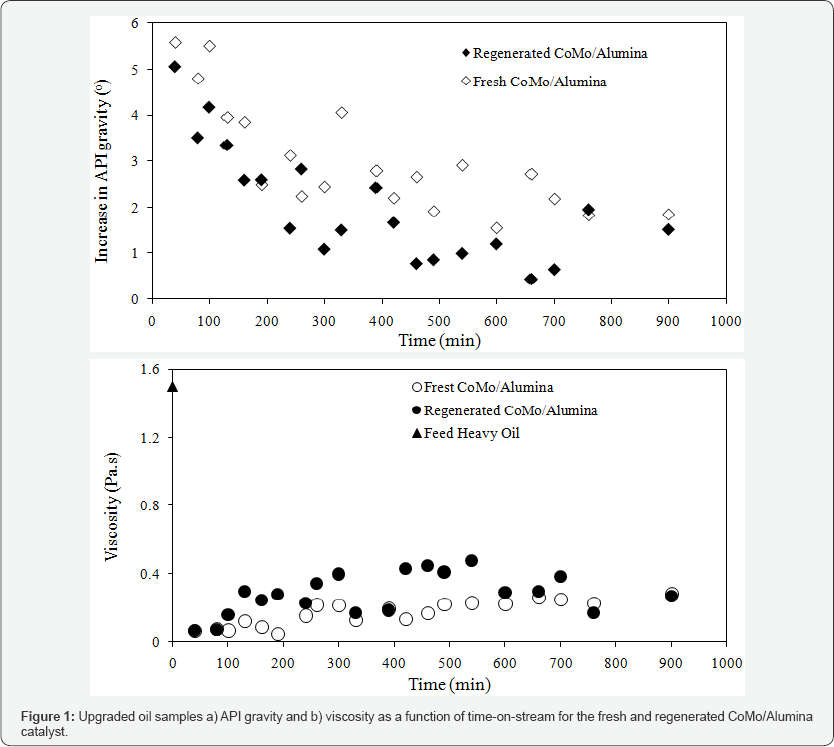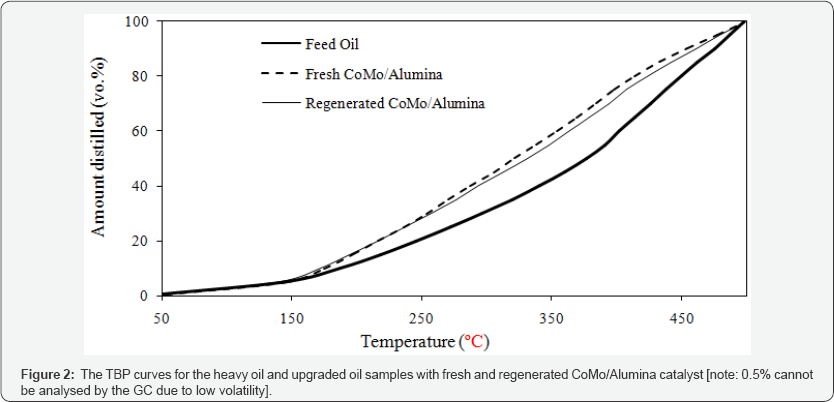How effective is Refinery Regenerated Catalyst for Downhole Catalytic Upgrading of Heavy Crude Oil?
Abarasi Hart*
School of Chemical Engineering, University of Birmingham, UK
Submission: January 08, 2018; Published: January 22, 2018
*Corresponding author: Abarasi Hart, School of Chemical Engineering, University of Birmingham, Edgbaston, Birmingham B15 2TT, UK, Tel: +44 [0) 1214145081; Email: a.hart@bham.ac.uk
How to cite this article: Abarasi H. How effective is Refinery Regenerated Catalyst for Downhole Catalytic Upgrading of Heavy Crude Oil?. Recent Adv Petrochem Sci. 2018; 4(2): 555633. DOI: 10.19080/RAPSCI.2018.04.555633
Abstract
The CAtalytic upgrading PRocess In-situ (CAPRI) incorporated with Toe-to-Heel Air Injection (THAI) for the recovery and in situ upgrading of heavy oils, was investigated at the laboratory-scale simulated on a fixed-bed reactor configuration at a temperature 425 °C, pressure 20 bar, oil flow rate 1mL min-1and gas (nitrogen)flow rate 500mL min-1The cost of catalyst and its rapid deactivation with the possibility of in situ regeneration very difficult has steered investigation into the use of cheap catalyst. In this study, refinery regenerated CoMo/Alumina catalyst was investigated for use in CAPRI and evaluated against its fresh counterpart. The level of upgrading was evaluated in terms of API gravity, viscosity reduction and true boiling point (TBP) distribution characteristics of the upgraded oil samples. Despite the regenerated CoMo/Alumina catalyst had experienced weakened acid sites due to partial surface coverage and pore plugging after its use in the refinery; it could achieve almost same level of upgrading as the fresh counterpart.
Keywords: Heavy oil; In situ upgrading; Regenerated catalyst
Introduction
Declining light crude oil remains a major source of transportation fuels. The ever increasing energy demand due to growing population and industrialization means approximately 25 million barrel/day of crude oil will need to be supplied to accommodate this rising consumption by 2020 [1]. In the face of peaked light crude oil, petroleum industries and researchers are depending on abundant reserves of heavy oil and bitumen in Canada, Venezuela, Middle East, Africa, Russia and the U.S.A to keep pace with rising consumption and create room for the transitions to a globally-sustainable low carbon energy systemto be commercialised [2].
Heavy oil and bitumen are well known for their extremely high viscosity, less than 20aAPI (American Petroleum Institute) gravity and poor fluidity, which make their recovery, pipeline transportation and refining difficult and as a consequence trade at a price quite below light oil. Therefore, without upgrading to produce a crude oil oflighter composition, heavy oil has very limited potential. Hence, once produced through thermal stimulation of the reservoir either via steam injection processes (eg, CSS, SAGD), fire flooding (eg, in situ combustion, Toe-to-Heel Air Injection (THAI)) or dilution such as vapour extraction (VAPEX), they are sent to surface upgrader to meet refining specifications [3]. The additional cost incurred for surface upgrading and the associated carbon footprint makes it discouraging to commercialize.
As a consequence attention has been shifted towards in situ upgrading based on the advantages its offers such as the reservoir can be viewed as a "free chemical reactor”, less carbon footprint, more desirable and valuable oil is produced and less challenges to pipelining. To configure the reservoir as free catalytic reactor require: 1) downhole bed of catalyst, 2) significantly high temperatures to initiate and sustain upgrading reactions and 3) a close contact between the mobilised oil and co-reactants over the catalyst bed [3,4]. CAtalytic upgrading Process In situ (CAPRI) incorporated with THAI technique fulfilled these requirements for downhole upgrading. In the THAI-CAPRI process, small portion of the original oil in place is combusted and the heat is used to mobilise and recover the rest oil as its viscosity is significantly reduced [4,5]. As the mobilised hot oil flows across the layer of catalyst incorporated onto the horizontal producer well, further upgrading through catalytic cracking is believed to occur [5]. Temperatures in the range of 450-700 °C can be achieved within the reservoir, which are sufficiently high temperatures to initiate and sustain upgrading reactions [4]. However, it has been reported that the catalyst suffers rapid deactivates, catalyst pore and bed plugging and eventually shutdown due to coke deposit resulting from the cracking heavy molecular weight species into low-boiling hydrocarbons [3,5]. Hence, the cost of catalyst and the possibility of in situ rejuvenation has become a potential issue. In this study therefore, a refinery waste regenerated CoMo/Al2O3 catalyst was tested and validated with the results achieved with its fresh counterpart.
Petrobank Energy and Resources, Ltd. (now Touchstone Exploration Inc.), Canada, supplied the heavy crude sample used in this study, obtained from their wells at Kerrobert, Saskatchewan, Canada. The heavy oil possess the following properties: API gravity (12.8°), viscosity (1.5 Pas), asphaltene (14 wt%), and sulfur content (3.1wt%). The catalyst is quadra-lobed shaped hydrotreating catalyst (CoMo/Alumina) with its surface area 58m2/g (regenerated) and 217m2/g(fresh). The regenerated CoMo/Alumina catalyst was obtained from Texaco, UK.
Materials and Methods

Briefly, the experiment was carried out at the optimum condition of temperature 425°C, pressure 20 bar, oil flow rate 1 mL min-1, and gas (nitrogen)flow rate 500 mL min-1[5]. The catalyst bed porosity is 0.46 with bed height of 12cm and reactor diameter of 1cm. The experimental set up and procedure have been reported in Hart [3] and Hart et al. [5].
The heavy oil before and after experiments was analysed using an Anton Paar DMA 35 portable density meter (Anton Paar GmbH, Austria) at 20 °C, advanced rheometer AR1000 (Malvern Instruments Ltd., United Kingdom) for viscosity measurement, and Agilent 6850N gas chromatography (GC) calibrated in accordance with the ASTMD2887 was used for true boiling point determination.
Results and Discussion
API Gravity and Viscosity
The increase in API gravity and viscosity of the upgraded oil samples are function of time-on-stream are presented in Figure 1. In spite of the differences in surface area, the level of upgrade by the regenerated CoMo/Alumina was comparable to that of the fresh counterpart for 200min of reaction (Figure 1a). It can be seen that the API gravity decreases from 5 ° point's increase to plateau at 2 ° for the regenerated catalyst while the fresh catalyst starts from 5.6 ° and settles at about 3 °.The rapid decrease in API gravity of upgraded oil samples observed from 40 to 300mins could be attributed to initial catalyst deactivation due to coke fouling from the cracking macromolecular weight species [3, 5-8].
Viscosity is an important parameter for heavy oil extraction and pipelining. Compared to 1.5 Pa.s viscosity of the heavy feed oil, the upgraded oil samples experienced significant decrease in viscosity (Figure 1b). On average the upgraded oil sample viscosity is 0.28 Pa.s (Regenerated CoMo/Alumina) and 0.17 Pa.s (Fresh CoMo/Alumina). This represent 0.11 Pa.s further decrease in viscosity with the fresh catalyst which is consistent with the 1 ° additional API gravity gained. This further level of upgrading experienced with fresh CoMo/Alumina can be attributed to its active acid sites and large surface area compared to the weakened active sites and partially plugged surfaces of the refinery regenerated counterpart.
True Boiling Point (TBP) Distribution
Simulated distillation was used to obtain the TBP curves for the heavy feed oil and upgraded oil samples by fresh and regenerated CoMo/Alumina catalyst as shown in Figure 2. The TBP curves are indicative of the shift in boiling fractions of the produced oil that has occurred as a result of the upgrading reacions [3].

The composition of upgraded oil samples have shown to contain lighter boiling hydrocarbons, that is naphtha and middle distillate fuel fractions compared the original feed oil. Between 50 and 250 °C the composition of the upgraded oil with fresh and regenerated CoMo/Alumina catalyst are approximately identical (Figure 2). However, beyond 250 °C the upgraded oil sample by fresh CoMo/Alumina catalyst contains more middle distillate fuel fraction and residue fraction than its regenerated counterpart. This is responsible for the further increase in API gravity and extra decrease in viscosity experienced on the upgraded oil samples with fresh catalyst over regenerated counterpart (Figure 1).
Conclusion
Due to high cost of hydrotreating catalyst and the difficulty of regenerating catalyst used for downhole catalytic upgrading of heavy oil, in this study, refinery regenerated CoMo/Alumina catalyst was investigated for in situ catalytic upgrading and evaluated against its fresh counterpart at temperature 425 °C, pressure 20 bar, oil flow rate 1 mL min-1, and gas (nitrogen) flow rate 500 mL min'Mt was found that at the early hours of operation the level of upgrading in terms of API gravity increase, viscosity reduction and distillation was approximately similar for both the fresh and regenerated CoMo/Alumina catalyst. However, additional upgrading up to 1 ° API gravity and 0.11 Pa s decrease in viscosity was observed with the fresh CoMo/Alumina catalyst. Compared to the small surface area and weakened active sites of regenerated catalyst after it has been used in the refinery, and with marginal difference in upgrading levels, it worthy to state that the regenerated CoMo/Alumina could achieve almost same level of upgrading as its fresh counterpart.
References
- Zitha P, Felder R, Zornes D, Brown K, Mohanty K, et al. (2011) Increasing Hydrocarbon Recovery Factors. Society of petroleum engineers.
- Hein JF (2017) Geology of bitumen and heavy oil: an overview. J Pet Sci Eng 154: 551-563.
- Hart A (2014) Advanced studies of catalytic upgrading of heavy oils. PhD Thesis, University of Birmingham.
- Ayasse C, Greaves M, Turta A (2002) Oilfield in situ hydrocarbon upgrading process, US Patent, No. 6412557 B1.
- Hart A, Shah A, Leeke G, Greaves M, Wood J, et al. (2013) Optimization of the CAPRI process for heavy oil upgrading: Effect of hydrogen and guard bed. Ind Eng Chem Res 52(44): 15394-15406.
- Hart A, Shah A, Leeke G, Greaves M (2017) In Situ Catalytic Upgrading of Heavy Oil Using a Pelletized Ni-Mo/Al2O3 Catalyst in the THAI Process. J Pet Sci Eng 156: 958-965.
- Hart A, Wood J, Greaves M (2017) Laboratory Investigation of CAPRI Catalytic THAI-add-on Process for Heavy Oil Production and In Situ Upgrading. J Anal Appl Pyrolysis 128: 18-26.
- Longstaff DC, Deo MD, Hanson FV (1994) Hydro treatment of bitumen from the White rocks oil sands deposit. Fuel 73(9): 1523-1530.






























